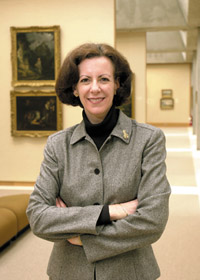 Between
the Lines
Between
the Lines
47
Mark Bauerlein's July 19 Chronicle of Higher Education essay, "Reviewers
are from Mars, Scholars are from Venus," contains references to plenty of
Chicagoans-including a half-dozen alumni academics and public intellectuals: George
Steiner, AB'48; Anthony Grafton, AB'71, AM'72, PhD'75; Gertrude Himmelfarb, AM'44,
PhD'60; Susan Sontag, AB'51; Richard Rorty, AB'49, AM'52; and David Brooks, AB'83.
Not mentioned by name, however, is Robert Silver, AB'47,
a founding editor of the New York Review of Books, known for its habit
of assigning writers to review books outside their fields. Bauerlein cites a 1999
scholarly protest prompted by a nonspecialist's NYRB review of five books
on Native-American history as the starting point for a discussion of academic
dismay with "a fast-track system of evaluation" in general publications.
Academics may prefer peer reviews in scholarly journals, Bauerlein notes, but
reviews like the NYRB's "are the arbiters of intellectual opinion
in the United States, and for professors to ignore that discourse is to aggravate
their isolation from the public sphere."
 |
Amy
Meyers, AB'77
photo by Michael Marsland |
52
In August Gonzalo Sanchez
de Lozada, AB'52, began a five-year term as president
of Bolivia. Sanchez de Lozada, a political centrist who also was president from
1993 to 1997, was elected August 4 by Bolivia's Congress, in an 84-43 victory
over Evo Morales, an Indian leader of Bolivia's coca growers. The Congress's vote
followed a June national election in which neither of two vote-getters won an
outright majority. According to the August 5 New York Times Sanchez de
Lozada faces "an opposition galvanized by the blunt-talking Mr. Morales,
whose Movement to Socialism party has given Bolivia's downtrodden Indian majority
a strong political voice."77
On September 1 Amy W. Meyers, AB'77, became the director
of the Yale Center for British Art. The first woman to head the center founded
by Paul Mellon, Meyers has a doctorate and two master's degrees from Yale and
was most recently curator of American art at the Henry E. Huntington Library,
Art Collections and Botanical Gardens in San Mateo, California. Here is how the
July 28 New York Times sums up her résumé: "[she] has
also worked at the Corcoran Gallery of Art and the National Gallery of Art, both
in Washington, has taught at six colleges and universities, organized symposiums,
written more than a dozen papers, collaborated with several other museums and
galleries on exhibitions, and has become known as a builder of museum collections."
82
The youngest of "five revolutionaries who changed the world"-this year's
winners of the annual Discover magazine awards for innovation in science and technology-is
Patrick O. Brown, AB'76, PhD'80, MD'82.
Brown is a Stanford University molecular biologist "whose invention of the
most widely used DNA microarray," proclaims the July 2002 Discover,
"helped to supercharge the pace of genetic discovery." Frustrated in
the early 1990s by the slow, gene-by-gene approach to breaking the genetic code,
Brown reasoned that researchers could learn the language of genes the way that
toddlers learn to speak: "by sampling widely." So Brown proposed a gene-sampling
machine, able to track thousands of genetic expressions on a single slide. When
the National Institutes of Health turned down that part of his grant proposal
as "too ambitious," Brown says, "My reaction was, what does anyone
know about it? I took the microarray out of the proposal, but I just decided I
would make one anyway."
88
In September Gerardo della Paolera, AM'85, PhD'88,
became president of the American University in Paris. The Argentine economist
is the first non-U.S. citizen to lead the school-a choice that, according to the
April 12 Chronicle of Higher Education, reflects the university's increasingly
global focus. The founding president of the Torcuato Di Tella University in Buenos
Aires, a post he held from 1990 to 2001, della Paolera will spend winter quarter
as a visiting professor at Chicago before settling into his new job full time.
-
Mary Ruth Yoe


![]() Contact
Contact
![]() About
the Magazine
About
the Magazine ![]() Alumni
Gateway
Alumni
Gateway ![]() Alumni
Directory
Alumni
Directory ![]() UChicago
UChicago![]() ©2002 The University
of Chicago® Magazine
©2002 The University
of Chicago® Magazine ![]() 5801 South Ellis Ave., Chicago, IL 60637
5801 South Ellis Ave., Chicago, IL 60637![]() fax: 773/702-0495
fax: 773/702-0495 ![]() uchicago-magazine@uchicago.edu
uchicago-magazine@uchicago.edu
